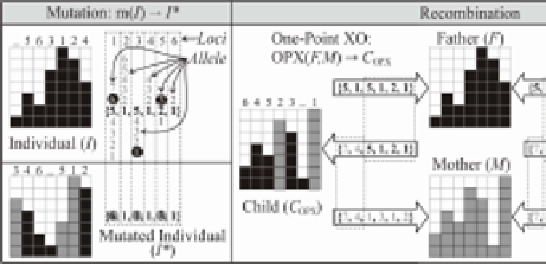Image Processing Reference
In-Depth Information
Fig. 11.20
Genetic operations on SIC*: On the left: mutation; on the right: two types of
recombination
uniform crossovers (UX). The possible values of the genes, so called
alleles
,insuch
a genotype are constrained, and depend on the
locus
, that is the position of a cer-
tain gene in the genotype. Initially, since there are
n
available positions in the list, a
gene can have
n
possible values. In the next step, since one position is already oc-
cupied, the allele is limited to
n
- 1, and so forth, up to the last gene in the genotype,
which can only have two values:
n
2, as shown on the left of Fig.
11.20. Mutation is controlled by two parameters: mutation radius
m
r
the maximal
difference of the mutated gene from the original value, and mutation intensity
m
i
,
the maximal number of genes to be mutated, which is expressed as a ratio to the
length of a genotype. The values of
m
r
and
m
i
in the example shown in Fig. 11.20
are 4 and 0.5, respectively. Figure 11.20 also illustrates two types of recombination:
the one-point crossover (OPX) where a single point on both parents' gene strings is
selected and the segments of genes are swapped between the two, and the uniform
crossover (UX), where each gene is drawn with equal probability from both parents.
The major advantage of OBR is that the operation of crossover (XO) is straightfor-
ward, and always yields feasible SIC* which represent allowable SIC. The process
of adjusting the parameters for various evolutionary techniques for optimization of
SIC for a 100
−
((
n
−
1
)
−
1
)=
×
100 cell CASS based on the {3818817080,2,2} CA is described
in [67]. Figure 11.21 compares the performance of five methods for an experiment
of 10 trials of 200 generations of population of cardinality of 50: evolution strat-
egy (ES), evolutionary algorithm with uniform crossover and mutation rates 0.1 and
0.4 (
EA
UX
0.1 and
EA
UX
0.1, respectively), EA with one-point XO and mutation
rates 0.1 and 0.4 (
EA
OPX
0.1 and
EA
OPX
0.1, respectively). Good results generated
by ES indicate that in this problem the operation of mutation is predominant. This
influence is also evident in
EA
OPX
where the higher mutation rate produces better
solutions. Good results obtained by
EA
UX
can also be attributed to the fact that UX
introduces more intensive alterations to a genotype than OPX. However, the best
overall result was obtained by
EA
OPX
indicating that the influence of crossover may
be an increasing factor in a long run. The selection of the method depends on the
designer's strategy. Table 11.4 collects the essential results. In a case of conservative






Search WWH ::

Custom Search